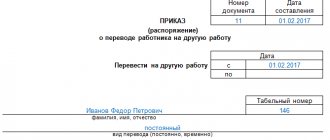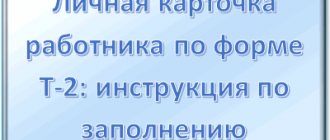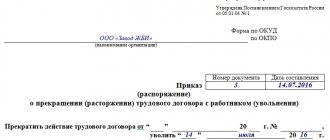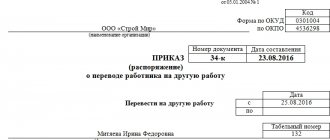A bonus order is an administrative document of an organization, which is issued if the manager decides to reward one or more employees for success at work, in honor of a holiday and for other reasons.
An employee's salary may consist of a salary and bonus parts. The salary part has a minimum threshold, indicated by the minimum wage rates, but the bonus part has no limits. In other words, the manager decides whether to assign a bonus to an employee or not, and he also determines the size of the bonus.
One of the ways to encourage an employee is to reward employees for work results, successful work, and achievement of high results. The employer is interested in increasing the efficiency of the company's performance indicators, therefore it has the right to motivate employees in the form of bonus payments. To formalize the decision, an administrative document on a one-time or permanent bonus is used. There are details that are recommended to be used in this form.
Basic rules for placing an order
As the current law states, an order for bonuses can be issued in a free form. However, many enterprises and organizations continue to actively use previously approved and generally applicable
- Form T-11 (if one employee is nominated for a bonus)
- or form T-11a (if bonuses are intended to be given to a group of employees).
Both of these forms are quite similar in both structure and content.
The adherence to the “old” forms is quite understandable: they include all the necessary data, including information about the employer and the employees being awarded, information about the reason for the bonus and the award itself, etc.
The order can be issued in two versions: either in writing, by hand, or in printed form. But no matter which one is chosen, it must always contain the original signature of the manager and the signatures of the awarded employees.
A document is drawn up in a single copy , which serves as the basis for further actions in relation to the awarded employees.
After registration, the order must be registered in the internal document register, then transferred first to the accounting department, and then for storage in the company’s archive.
When is an employee rewarded?
Payment of additional remuneration is an internal matter of each employer. The organization has the right to independently determine how to provide bonuses to employees for work results, its frequency, reasons and amounts of bonus payments to employees.
Rewards are divided into regular (monthly, quarterly, annual) and one-time.
Labor Code of the Russian Federation in Art. 129, 135 allows you to include a bonus in the list of payments in the remuneration system. This means that the employer designates it in a local regulatory document (regulation) as one of the types of payment for work. The employee receives it regularly.
The employer, if financially possible, pays one-time bonuses. They are not regular and are not part of the wage system.
Common reasons for such bonuses are:
- significant dates for an employee or the entire company: birthday, organization anniversary, professional holiday;
- All-Russian holidays - New Year, March 8;
- merits in work: an employee is encouraged, for example, if he exceeded the production standard, achieved production optimization, reduced defect rates, initiated transformations useful for production, and reduced production costs without loss of quality.
It is permissible to award bonuses to only one or several employees at the same time.
Example of filling out order T-11
Standard forms T-11 or T-11a are quite simple and understandable, so they should not cause any difficulties when filling out.
In the first part of document T-11, which was developed for bonuses for one employee, the full name of the company, OKPO code (in accordance with registration papers), as well as the order number for internal document flow and the date of preparation are indicated first.
Then in the form you need to enter the last name, first name, patronymic of the employee, his personnel number (if such records are kept at the enterprise), the name of the position and structural unit (site, workshop, team) in which the applicant for the award works.
In the second part of the order, you must indicate the motive, i.e. the reason for the award, then its type, and if it is a sum of money, then its exact amount (in words and figures).
In the line “ Base ”, a specific document is written on the basis of which the bonus is awarded (its date and number, if one was assigned).
Finally, the order is signed by the head of the organization, dated, and then handed over to the awarded employee for review and signature.
Types of employee incentives
It is allowed to encourage an employee not only in material form. The main types of incentives used in practice:
- announcement of gratitude;
- cash bonus;
- nomination for the title of the best in the profession;
- issuance of a valuable gift;
- awarding a certificate of honor.
The list, in accordance with Art. 191 of the Labor Code of the Russian Federation is not closed; the bonus system is established for each specific enterprise in local regulations. For special achievements, a presentation for state awards may follow.
Example of filling out order T-11a
This order form is filled out when a group of employees is expected to receive bonuses.
The first part of form T-11a almost exactly repeats the contents of form T-11 and is also filled out in the same way. The difference is that the full name and department in which a particular employee works is not indicated here, but instead the incentive motive and its type are written.
In the second part of the document, first there is a table in which the full name of each bonused employee, his personnel number, as well as the structural unit to which he belongs are entered in order (it should be noted that employees may belong to different departments of the enterprise). Then the position of the employees and the amount of bonus due to each of them is indicated (the amount of the bonus may vary).
Next, in the line below the basis , with reference to the date and document number, and the signature of the manager is also affixed. After the order is approved by the director, it is handed over to each employee for review, who must put his signature in the appropriate table opposite his last name.
How is the award issued?
The procedure for bonuses, the algorithm for how to write to reward an employee with a cash bonus, is established by an internal act of the organization - the regulations on bonuses. It establishes cases and indicators upon achievement of which employees are entitled to incentive payments. The regulations also prescribe the need for a monthly incentive supplement, often set as a percentage of the salary.
The presence of a provision on bonuses is especially important for budgetary organizations that pay additional remunerations from the wage fund allocated from the budget. Regulations on bonuses for budgetary institutions are developed on the basis of departmental acts of the system in which the institution is located.
For the payment of each individual remuneration, a special order on bonuses is issued.
ConsultantPlus experts discussed how to formalize and account for employee bonuses in accounting. Use these instructions for free.
to read.
Related documents
- Order (instruction) on granting leave to employees. Form N T-6a
- Order (instruction) on granting leave to an employee. Form N T-6
- Order (instruction) on termination (termination) of an employment contract with employees (dismissal). Form N T-8a
- Order (instruction) on termination (termination) of an employment contract with an employee (dismissal). Form N T-8
- Order (instruction) on hiring an employee. Form N T-1
- Order (instruction) on hiring employees. Form N T-1a
- An official assignment for sending on a business trip and a report on its implementation. Form N T-10a
- Registration card of a scientific, scientific and pedagogical worker. Form N T-4
- A note indicating the provision of leave to an employee. Form N T-60
- Personal account (svt). Form N T-54a
- Personal account. Form N T-54
- Payslip. Form N T-51
- Payroll. Form N T-49
- Timesheets for recording working hours and calculating wages. Form N T-12
- Time sheet. Form N T-13
- Staffing schedule. Form N T-3
- Certificate of commissioning of a temporary (non-title) structure (Unified Form N KS-8)
- Certificate of acceptance of the completed construction of the facility by the acceptance committee (Standard interindustry form N KS-14)
- General work log (Standard intersectoral form N KS-6)
- Act on cleaning the pile (trench, vegetable storage) (Unified form N MX-17)
Reasons
Organizations need to take into account nuances when developing Regulations. An important factor is the financial position of the company. You need to pay attention to the fact that there must be several reasons for payments. These include:
- implementation of complex tasks;
- excess production according to standard hours;
- company anniversary;
- exceeding the established plan;
- performing job duties for a certain period;
- prof. celebrations.
Law
The main act that regulates the calculation of bonuses is the Labor Code. Such provisions are reflected in Articles 191, 129, 144 and 135. The Unified Recommendations, which were developed at the federal level, deserve attention. They are used at the municipal and regional levels. The act is approved at the federation level. A tripartite commission is responsible for this.
The commission includes employers, prof. unions and the Government of the country. Separate recommendations are developed for each industry. The Ministry of Health adopted the order in 2013. The document has number 421.
Let's sum it up
- The basis for drawing up an order to reward an employee is the submission (petition, memo) of the employee’s immediate supervisor.
- An incentive order can be drawn up in free form or use a unified one: T-11 - if there is only one employee and T-11a - if there are several of them.
- Information about the incentive must be entered into the work book and the employee’s personal card.
If you find an error, please select a piece of text and press Ctrl+Enter.
Are there criteria for judging good work?
Labor evaluation criteria are the key parameters on which the performance of employees (individually or collectively) is based. The evaluation criteria are responsible for determining how the functional responsibilities will be performed to meet the necessary requirements of the enterprise and customer base.
The criteria are divided into groups:
- Organization-wide criteria - applicable to all personnel working in the company who fulfill their duties in a timely and complete manner. These criteria are specialized and must correspond to your workplace and type of activity.
- Quantitative criteria - are assessed on the basis of the results already achieved in the work (determining the quantity of products produced individually by each employee in excess of the norm), while assessing the quality of the product and labor productivity.
- Objective criteria are when standards, required labor productivity, standards are established by the manager for almost all types of work. In fact, an assessment of all work performed is made.
- Subjective criteria - assessed based on expert opinion.
- Integral criteria are based on a combination of the evaluation process and several indicators at the same time. This may be compliance with the internal rules of the company, the quality of work performed, services provided, the time spent on their implementation or provision.
- Simple criteria. An assessment of certain aspects of the employee’s work is carried out, and the HR department inspector selects a certain indicator for which he identifies all the necessary data.
Any independent enterprise, based on an order from management, has the right to adjust and develop additional criteria independently. They must correspond to the type of organization and reflect the quality of the employees’ activities and must not go beyond the current legislation.
Determination of payments
Employees do not know what incentive payments are.
The legislator defines them as incentives expressed in financial form. Conditions for receiving payments:
- whether the person has completed training;
- volume of labor produced;
- scope of qualifications;
- level of complexity of the work performed;
- quality of fulfillment of obligations;
- the severity of labor.
Such payments are considered as part of earnings. The law reflects an open list of payments due to employees. This suggests that the employer can introduce new types of payments. The method is chosen at the discretion of the company management. If we talk about regulating the issue by law, then we can highlight a couple of main acts.
The main one is the Labor Code. It contains the amount of allowances that employees are entitled to. Conditions for accrual are specified. These are other legislative acts. They reflect other types of surcharges. Their goal is encouragement.
Citizens can count on incentives from the company based on the provisions of labor law. The basis is the collective agreement in force in the organization. The act is signed at the time of registration of the employment relationship.
What sections do they consist of?
Title
At the beginning of the document, information about the organization (its originator) and initial information about the order are included.
The name of the organization is written in all official documents (and in the order on promotion too), according to the designation enshrined in the constituent documents (including foreign names and abbreviations).
In the presence of abbreviations, the full name comes first, followed by the abbreviation in brackets.
Meaningful
This is the main section of the document where the whole meaning and application is contained:
- The worker's full name is written in full in the nominative case.
- The order must include the employee’s personnel number (assigned to the person when applying for a job).
- The structural unit where the employee works is registered (when applying for a job in a structural unit). It is also written in the nominative case. If missing, this line is skipped.
- Name of position, profession, specialization in full (name).
- The motive for the award (when using the phrase “conscientious performance by the employee of labor duties,” you need to justify what exactly is meant by this).









